Toxicological Effects of Silver and Zinc Oxide Nanoparticles on the Biological and Life Table Parameters of Helicoverpa armigera (Noctuidae: Lepidoptera)
Abstract
:1. Introduction
2. Materials and Methods
2.1. Experimental Conditions and Insect Rearing
2.2. Plant Sources and Preparation of Leaf Extract
2.3. Synthesis of Silver and Zinc Oxide Nanoparticles
2.4. Characterization of Silver and Zinc Nanoparticles
2.4.1. Ultraviolet Spectroscopy
2.4.2. SEM and EDX Analysis
2.4.3. Larvicidal Activity
2.4.4. Life Table Parameters
2.5. Data Analysis
3. Results
3.1. Effect of Ag NPs and Zinc Oxide NPs on Mortality of H. armigera
3.2. Toxicological Evaluation of Tested NPs on Larvae of H. armigera
3.3. Life Table of H. armigera against Tested NPs
3.4. Effects of Ag and ZnO NPs on the Biological Parameter of Helicoverpa armigera
3.5. Age-Specific Survival Rate (sxj), Life Expectancy (exj) and Age Stage Reproductive Value (Vxj) after Applying Tested NPs
3.6. Analysis of Ag NPs
3.6.1. Visual and Ultraviolet Spectroscopy Observation
3.6.2. Scanning Electron Microscopy (SEM) and Energy-Dispersive X-ray (EDX) Analysis
3.7. Analysis of ZnO NPs
3.7.1. Visual and Ultraviolet Spectroscopy Observation
3.7.2. Scanning Electron Microscopy (SEM) and Energy-Dispersive X-ray (EDX) Analysis
4. Discussion
5. Conclusions
Author Contributions
Funding
Institutional Review Board Statement
Informed Consent Statement
Data Availability Statement
Conflicts of Interest
References
- Riaz, S.; Johnson, J.B.; Ahmad, M.; Fitt, G.P.; Naiker, M. A review on biological interactions and management of the cotton bollworm, Helicoverpa armigera (Lepidoptera: Noctuidae). J. Appl. Entomol. 2021, 145, 467–498. [Google Scholar] [CrossRef]
- Subramanian, S.; Mohankumar, S. Genetic variability of the bollworm, Helicoverpa armigera, occurring on different host plants. J. Insect Sci. 2006, 6, 26. [Google Scholar] [CrossRef] [Green Version]
- Devi, G.D.; Murugan, K.; Selvam, C.P. Green synthesis of silver nanoparticles using Euphorbia hirta (Euphorbiaceae) leaf extract against crop pest of cotton bollworm, Helicoverpa armigera (Lepidoptera: Noctuidae). J. Biopestic. 2014, 7, 54. [Google Scholar]
- Kumar, R.; Kranthi, S.; Rao, G.P.; Desai, H.; Bheemanna, H.; Dharajothi, B.; Choudhary, A.; Kranthi, K. Assessment of bollworm damage and yield loss in seed blends of Bollgard-II with corresponding Non-Bt hybrid as ‘built in refuge’ in cotton. Phytoparasitica 2021, 49, 253–263. [Google Scholar] [CrossRef]
- Barmukh, R.; Roorkiwal, M.; Jaba, J.; Chitikineni, A.; Mishra, S.P.; Sagurthi, S.R.; Munghate, R.; Sharma, H.; Varshney, R.K. Development of a dense genetic map and QTL analysis for pod borer Helicoverpa armigera (Hübner) resistance component traits in chickpea (Cicer arietinum L.). Plant Genome 2021, 14, e20071. [Google Scholar] [CrossRef] [PubMed]
- Yogindran, S.; Rajam, M.V. Host-derived artificial miRNA-mediated silencing of ecdysone receptor gene provides enhanced resistance to Helicoverpa armigera in tomato. Genomics 2021, 113, 736–747. [Google Scholar] [CrossRef]
- Sári-Barnácz, F.; Szalai, M.; Kun, M.; Iványi, D.; Chaddadi, M.; Barnácz, F.; Kiss, J. Satellite-Based Spectral Indices for Monitoring Helicoverpa Armigera Damage in Maize, Precision Agriculture’ 21; Wageningen Academic Publishers: Wageningen, The Netherlands, 2021; pp. 1139–1147. [Google Scholar] [CrossRef]
- Sekine, T.; Kanao, K.; Inawashiro, S.; Hori, M. Insect pest management by intercropping with leafy daikon (Raphanus sativus) in cabbage fields. Arthropod-Plant Interact. 2021, 15, 669–681. [Google Scholar] [CrossRef]
- Chakravarty, S.; Padwal, K.; Srivastava, C. Molecular characterization of intraspecific variations in Helicoverpa armigera (Hübner) populations across India. J. Environ. Biol. 2021, 42, 1320–1329. [Google Scholar] [CrossRef]
- Das, S.K. Scope and relevance of using pesticide mixtures in crop protection: A critical review. Int. J. Environ. Sci. Technol. 2014, 2, 119–123. [Google Scholar]
- Casida, J.E. Pest toxicology: The primary mechanisms of pesticide action. Chem. Res. Toxicol. 2009, 22, 609–619. [Google Scholar] [CrossRef] [PubMed]
- Saddiq, B.; Shad, S.A.; Khan, H.A.A.; Aslam, M.; Ejaz, M.; Afzal, M.B.S. Resistance in the mealybug Phenacoccus solenopsis Tinsley (Homoptera: Pseudococcidae) in Pakistan to selected organophosphate and pyrethroid insecticides. Crop Prot. 2014, 66, 29–33. [Google Scholar] [CrossRef]
- Qayyum, M.A.; Wakil, W.; Arif, M.J.; Sahi, S.T.; Saeed, N.A.; Russell, D.A. Multiple resistances against formulated organophosphates, pyrethroids, and newer-chemistry insecticides in populations of Helicoverpa armigera (Lepidoptera: Noctuidae) from Pakistan. J. Econ. Entomol. 2015, 108, 286–293. [Google Scholar] [CrossRef] [PubMed]
- Head, G.P.; Greenplate, J. The design and implementation of insect resistance management programs for Bt crops. GM Crops Food 2012, 3, 144–153. [Google Scholar] [CrossRef] [PubMed] [Green Version]
- Alvi, A.H.; Sayyed, A.H.; Naeem, M.; Ali, M. Field evolved resistance in Helicoverpa armigera (Lepidoptera: Noctuidae) to Bacillus thuringiensis toxin Cry1Ac in Pakistan. PLoS ONE 2012, 7, e47309. [Google Scholar] [CrossRef] [PubMed] [Green Version]
- Jin, L.; Zhang, H.; Lu, Y.; Yang, Y.; Wu, K.; Tabashnik, B.E.; Wu, Y. Large-scale test of the natural refuge strategy for delaying insect resistance to transgenic Bt crops. Nat. Biotechnol. 2015, 33, 169–174. [Google Scholar] [CrossRef] [PubMed]
- Singh, R.P.; Handa, R.; Manchanda, G. Nanoparticles in sustainable agriculture: An emerging opportunity. J. Control. Release 2021, 329, 1234–1248. [Google Scholar] [CrossRef] [PubMed]
- Yah, C.S.; Simate, G.S. Nanoparticles as potential new generation broad spectrum antimicrobial agents. DARU J. Pharm. Sci. 2015, 23, 43. [Google Scholar] [CrossRef] [Green Version]
- Mohanpuria, P.; Rana, N.K.; Yadav, S.K. Biosynthesis of nanoparticles: Technological concepts and future applications. J. Nanopart. Res. 2008, 10, 507–517. [Google Scholar] [CrossRef]
- Willems, V.D.W. Roadmap Report on Nanoparticles; W&W Espana sl: Barcelona, Spain, 2005; p. 157. [Google Scholar]
- Verma, A.; Mehata, M.S. Controllable synthesis of silver nanoparticles using Neem leaves and their antimicrobial activity. J. Radiat. Res. Appl. 2016, 9, 109–115. [Google Scholar] [CrossRef] [Green Version]
- Ahmad, S.; Ansari, M.S. Acute toxicity and sub-lethal effects of a pyrethroid (cypermethrin) on survival, development and fitness of Helicoverpa armigera. Arch. Phytopathol. Plant Prot. 2013, 46, 1726–1739. [Google Scholar] [CrossRef]
- Jarrahi, A.; Safavi, S.A. Fitness costs to Helicoverpa armigera after exposure to sub-lethal concentrations of Metarhizium anisopliae sensu lato: Study on F1 generation. J. Invertebr. Pathol. 2016, 138, 50–56. [Google Scholar] [CrossRef]
- Chi, H. Life table analysis incorporating both sexes and variable development rates among individuals. Environ. Entomol. 1988, 17, 26–34. [Google Scholar] [CrossRef]
- Chi, H.; You, M.; Atlihan, R.; Smith, C.L.; Kavousi, A.; Özgökçe, M.S.; Güncan, A.; Tuan, S.J.; Fu, J.W.; Xu, Y.Y. Age-stage, two-sex life table: An introduction to theory, data analysis, and application. Entomol. Gen. 2020, 40, 102–123. [Google Scholar] [CrossRef]
- Shoukat, R.F.; Zafar, J.; Shakeel, M.; Zhang, Y.; Freed, S.; Xu, X.; Jin, F. Assessment of lethal, sublethal, and transgenerational effects of Beauveria bassiana on the demography of Aedes albopictus (Culicidae: Diptera). Insects 2020, 11, 178. [Google Scholar] [CrossRef] [Green Version]
- Rueda, L.; Patel, K.; Axtell, R.; Stinner, R. Temperature-dependent development and survival rates of Culex quinquefasciatus and Aedes aegypti (Diptera: Culicidae). J. Med. Entomol. 1990, 27, 892–898. [Google Scholar] [CrossRef]
- Sowilem, M.M.; Kamal, H.A.; Khater, E.I. Life table characteristics of Aedes aegypti (Diptera: Culicidae) from Saudi Arabia. Trop Biomed. 2013, 30, 301–314. [Google Scholar]
- Chi, H. Timing of control based on the stage structure of pest populations: A simulation approach. J. Econ. Entomol. 1990, 83, 1143–1150. [Google Scholar] [CrossRef]
- Yu, J.Z.; Chi, H.; Chen, B.H. Life table and predation of Lemnia biplagiata (Coleoptera: Coccinellidae) fed on Aphis gossypii (Homoptera: Aphididae) with a proof on relationship among gross reproduction rate, net reproduction rate, and preadult survivorship. Ann. Entomol. Soc. Am. 2005, 98, 475–482. [Google Scholar] [CrossRef] [Green Version]
- Krishnareddy, B.; Hanur, V.S. Enhanced synthetic diet for rearing H. armigera under laboratory conditions. J. Entomol. Zool. Stud. 2015, 3, 165–167. [Google Scholar]
- Ahmed, K.; Khalique, F.; Malik, B.A. Modified artificial diet for mass rearing of Chickpea Pod borer, Helicoverpa armigera (H.). Pak. J. Biol. Sci. 1998, 1, 183–187. [Google Scholar] [CrossRef]
- Sekhar, E.C.; Rao, K.; Rao, K.M.S.; Alisha, S.B. A simple biosynthesis of silver nanoparticles from Syzygium cumini stem bark aqueous extract and their spectrochemical and antimicrobial studies. J. Appl. Pharm. Sci. 2018, 8, 73–79. [Google Scholar]
- Roy, P.; Das, B.; Mohanty, A.; Mohapatra, S. Green synthesis of silver nanoparticles using Azadirachta indica leaf extract and its antimicrobial study. Appl. Nanosci. 2017, 7, 843–850. [Google Scholar] [CrossRef] [Green Version]
- Senthilkumar, S.; Sivakumar, T. Green tea (Camellia sinensis) mediated synthesis of zinc oxide (ZnO) nanoparticles and studies on their antimicrobial activities. Int. J. Pharm. Pharm. Sci. 2014, 6, 461–465. [Google Scholar]
- Manimegalai, T.; Raguvaran, K.; Kalpana, M.; Maheswaran, R. Green synthesis of silver nanoparticle using Leonotis nepetifolia and their toxicity against vector mosquitoes of Aedes aegypti and Culex quinquefasciatus and agricultural pests of Spodoptera litura and Helicoverpa armigera. Environ. Sci. Pollut. Res. 2020, 27, 43103–43116. [Google Scholar] [CrossRef] [PubMed]
- Abbas, N.; Hafez, A.M. Resistance to insect growth regulators and age-stage, two-sex life table in Musca domestica from different dairy facilities. PLoS ONE 2021, 16, e0248693. [Google Scholar] [CrossRef] [PubMed]
- Chi, H.; Su, H.Y. Age-stage, two-sex life tables of Aphidius gifuensis (Ashmead) (Hymenoptera: Braconidae) and its host Myzus persicae (Sulzer) (Homoptera: Aphididae) with mathematical proof of the relationship between female fecundity and the net reproductive rate. Environ. Entomol. 2006, 35, 10–21. [Google Scholar] [CrossRef]
- Tuan, S.J.; Lee, C.C.; Chi, H. Population and damage projection of Spodoptera litura (F.) on peanuts (Arachis hypogaea L.) under different conditions using the age-stage, two-sex life table. Pest. Manag. Sci. 2014, 70, 805–813. [Google Scholar] [CrossRef]
- Farrokhi, M.; Gharekhani, G.; Iranipour, S.; Hassanpour, M. Host plant–herbivore–predator interactions in Chrysoperla carnea (Neuroptera: Chrysopidae) and Myzus persicae (Homoptera: Aphididae) on four plant species under laboratory conditions. J. Econ. Entomol. 2017, 110, 2342–2350. [Google Scholar] [CrossRef]
- Goodman, D. Optimal life histories, optimal notation, and the value of reproductive value. Am. Nat. 1982, 119, 803–823. [Google Scholar] [CrossRef]
- Finney, D. Probit Analysis; Cambridge University Press: Cambridge, UK, 1971. [Google Scholar]
- Meyer, J.S.; Ingersoll, C.G.; McDonald, L.L.; Boyce, M.S. Estimating uncertainty in population growth rates: Jackknife vs. bootstrap techniques. Ecology 1986, 67, 1156–1166. [Google Scholar] [CrossRef] [Green Version]
- Rouhani, M.; Samih, M.A.; Kalantari, S. Insecticied effect of silver and zinc nanoparticles against Aphis nerii Boyer of fonscolombe (Hemiptera: Aphididae). Chil. J. Agric. Res. 2012, 72, 590–594. [Google Scholar] [CrossRef] [Green Version]
- Rajula, J.; Rahman, A.; Krutmuang, P. Entomopathogenic fungi in Southeast Asia and Africa and their possible adoption in biological control. Biol. Control 2020, 151, 104399. [Google Scholar] [CrossRef]
- Guan, H.; Chi, D.; Yu, J.; Li, X. A novel photodegradable insecticide: Preparation, characterization and properties evaluation of nano-Imidacloprid. Pestic. Biochem. Physiol. 2008, 92, 83–91. [Google Scholar] [CrossRef]
- Rasheed, T.; Bilal, M.; Iqbal, H.M.; Li, C. Green biosynthesis of silver nanoparticles using leaves extract of Artemisia vulgaris and their potential biomedical applications. Colloids Surf. B Biointerfaces 2017, 158, 408–415. [Google Scholar] [CrossRef] [PubMed]
- Kumar, V.; Yadav, S.K. Plant mediated synthesis of silver and gold nanoparticles and their applications. J. Chem. Technol. Biotechnol. Int. Res. Process Environ. Clean Technol. 2009, 84, 151–157. [Google Scholar] [CrossRef]
- Priyadarshini, K.A.; Murugan, K.; Panneerselvam, C.; Ponarulselvam, S.; Hwang, J.S.; Nicoletti, M. Biolarvicidal and pupicidal potential of silver nanoparticles synthesized using Euphorbia hirta against Anopheles stephensi Liston (Diptera: Culicidae). Parasitol. Res. 2012, 111, 997–1006. [Google Scholar] [CrossRef] [PubMed]
- Manimegalai, T.; Raguvaran, K.; Kalpana, M.; Maheswaran, R. Facile Synthesis of Silver Nanoparticles Using Vernonia anthelmintica (L.) Willd. and Their Toxicity against Spodoptera litura (Fab.), Helicoverpa armigera (Hüb.), Aedes aegypti Linn. and Culex quinquefasciatus Say. J. Clust. Sci. 2021, 33, 2287–2303. [Google Scholar] [CrossRef]
- Ammar, H.A.; Abd-ElAzeem, E.M. Novel treatment of gelatin-copper bio-nanoparticles as a management method against the spiny bollworm, Earias insulana, (Boisd.) (Lepidoptera: Noctuidae) in comparison studies with the uncoated nanoparticles. Inorg. Nano-Met. Chem. 2021, 51, 309–321. [Google Scholar] [CrossRef]
- Queiroz-Santos, L.; Casagrande, M.; Specht, A. Morphological characterization of Helicoverpa armigera (Hübner) (Lepidoptera: Noctuidae: Heliothinae). Neotrop. Entomol. 2018, 47, 517–542. [Google Scholar] [CrossRef] [PubMed] [Green Version]
- Shah, R.M.; Shad, S.A.; Abbas, N. Methoxyfenozide resistance of the housefly, Musca domestica L.(Diptera: Muscidae): Cross resistance patterns, stability and associated fitness costs. Pest. Manag. Sci. 2017, 73, 254–261. [Google Scholar] [CrossRef] [PubMed]
- Abbas, N.; Khan, H.; Shad, S.A. Cross-resistance, stability, and fitness cost of resistance to imidacloprid in Musca domestica L., (Diptera: Muscidae). Parasitol. Res. 2015, 114, 247–255. [Google Scholar] [CrossRef] [PubMed]
- Chen, Q.; Li, N.; Wang, X.; Ma, L.; Huang, J.B.; Huang, G.H. Age-stage, two-sex life table of Parapoynx crisonalis (Lepidoptera: Pyralidae) at different temperatures. PLoS ONE 2017, 12, e0173380. [Google Scholar] [CrossRef] [PubMed] [Green Version]
- Pan, Q.J.; Chen, L.; Lin, X.L.; Ridsdill-Smith, T.J.; Liu, T.X. Geographical variations in life histories of Plutella xylostella in China. J. Pestic. Sci. 2014, 87, 659–670. [Google Scholar] [CrossRef]
- Jafir, M.; Ahmad, J.N.; Arif, M.J.; Ali, S.; Ahmad, S.J.N. Characterization of Ocimum basilicum synthesized silver nanoparticles and its relative toxicity to some insecticides against tobacco cutworm, Spodoptera litura Feb. (Lepidoptera; Noctuidae). Ecotox. Environ. Saf. 2021, 218, 112278. [Google Scholar] [CrossRef]
- Suresh, U.; Murugan, K.; Benelli, G.; Nicoletti, M.; Barnard, D.R.; Panneerselvam, C.; Kumar, P.M.; Subramaniam, J.; Dinesh, D.; Chandramohan, B. Tackling the growing threat of dengue: Phyllanthus niruri-mediated synthesis of silver nanoparticles and their mosquitocidal properties against the dengue vector Aedes aegypti (Diptera: Culicidae). Parasitol. Res. 2015, 114, 1551–1562. [Google Scholar] [CrossRef]
- Fayaz, A.M.; Balaji, K.; Girilal, M.; Yadav, R.; Kalaichelvan, P.T.; Venketesan, R. Biogenic synthesis of silver nanoparticles and their synergistic effect with antibiotics: A study against gram-positive and gram-negative bacteria. Nanomed. Nanotechnol. Biol. Med. 2010, 6, 103–109. [Google Scholar] [CrossRef] [PubMed]
- Shukla, G.; Gaurav, S.S.; Singh, A. Synthesis of mycogenic zinc oxide nanoparticles and preliminary determination of its efficacy as a larvicide against white grubs (Holotrichia sp.). Int. Nano. Lett. 2020, 10, 131–139. [Google Scholar] [CrossRef]
- Umar, H.; Kavaz, D.; Rizaner, N. Biosynthesis of zinc oxide nanoparticles using Albizia lebbeck stem bark, and evaluation of its antimicrobial, antioxidant, and cytotoxic activities on human breast cancer cell lines. Int. J. Nanomed. 2019, 14, 87–100. [Google Scholar] [CrossRef]

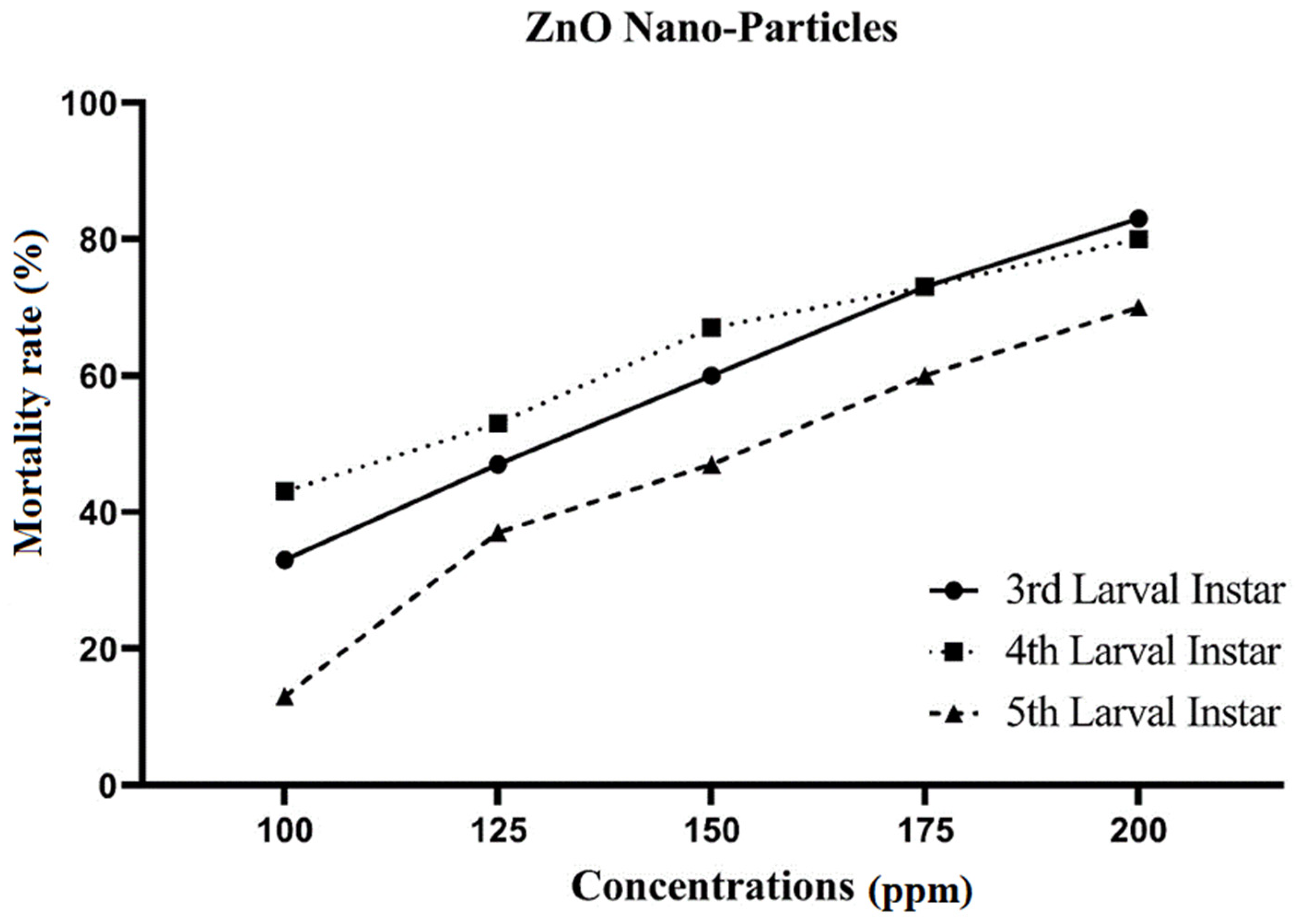


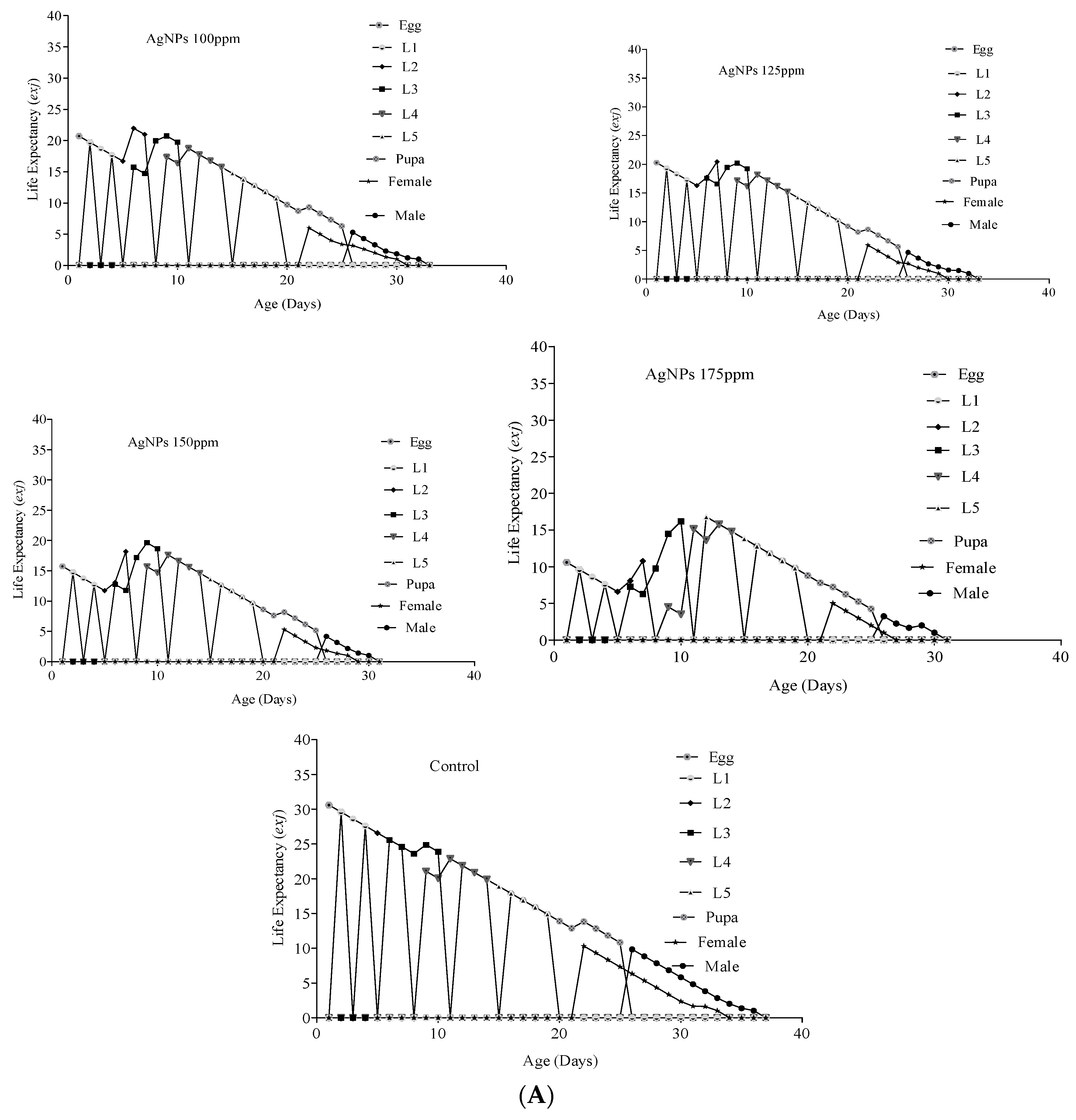
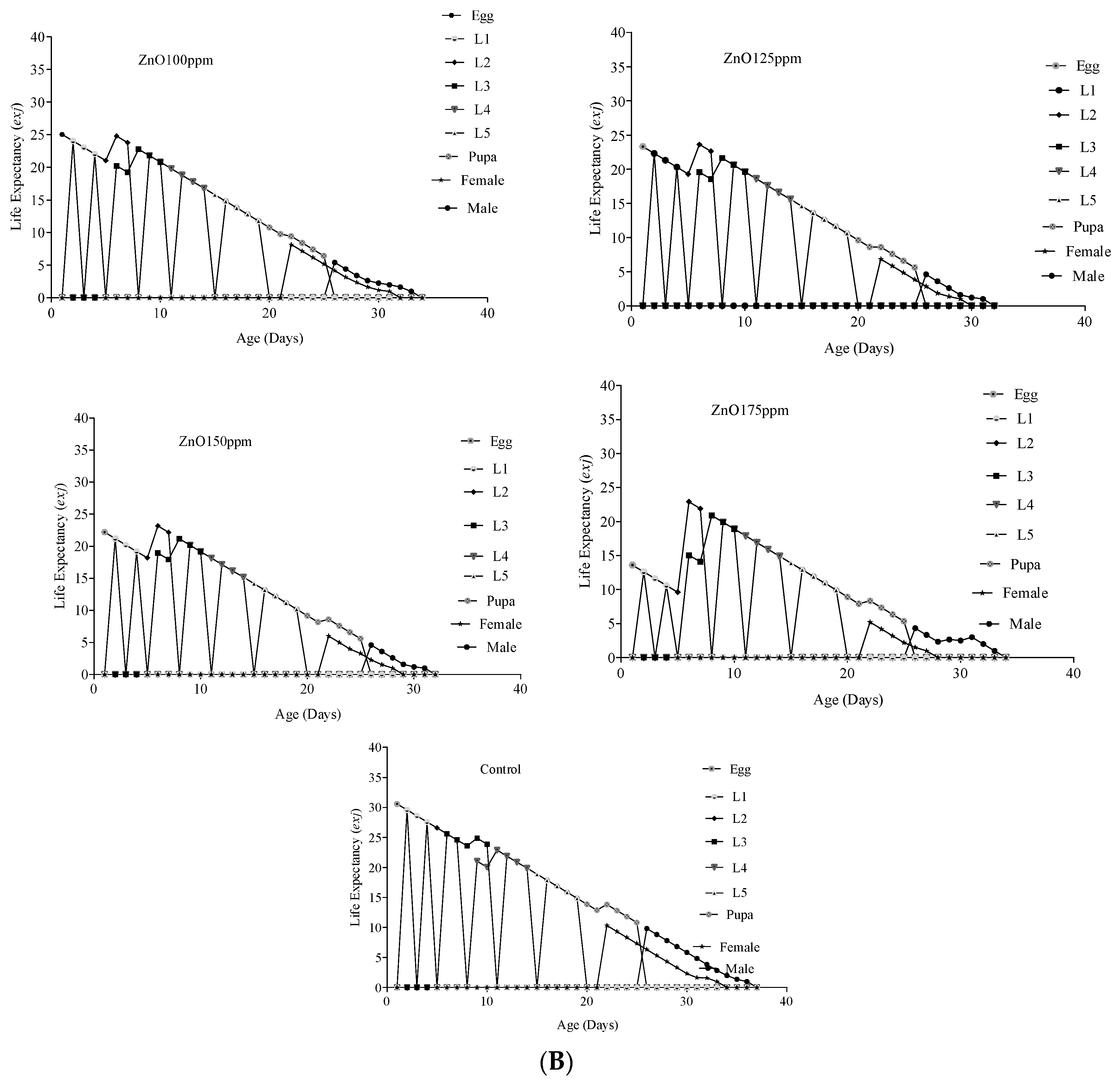
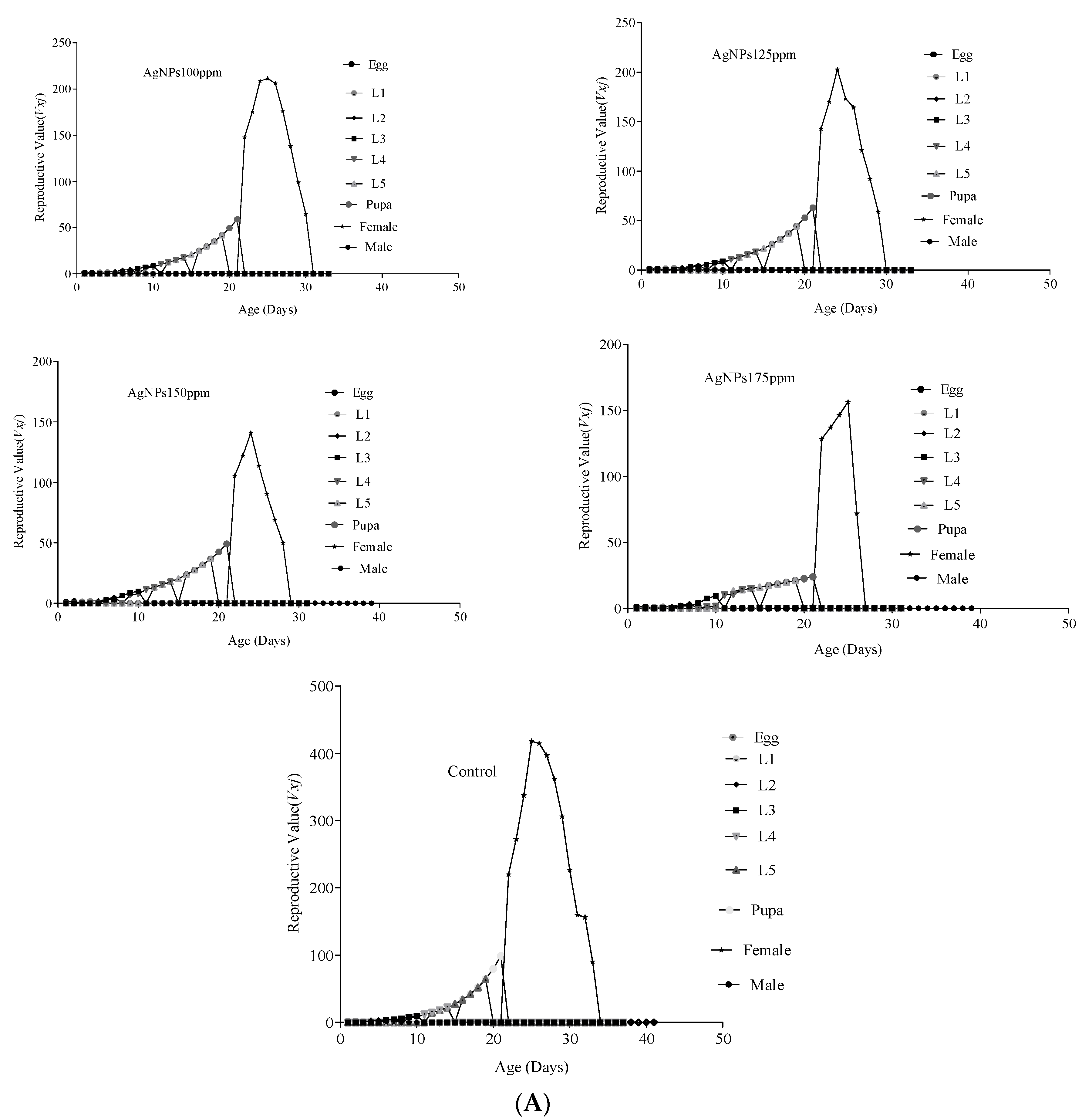
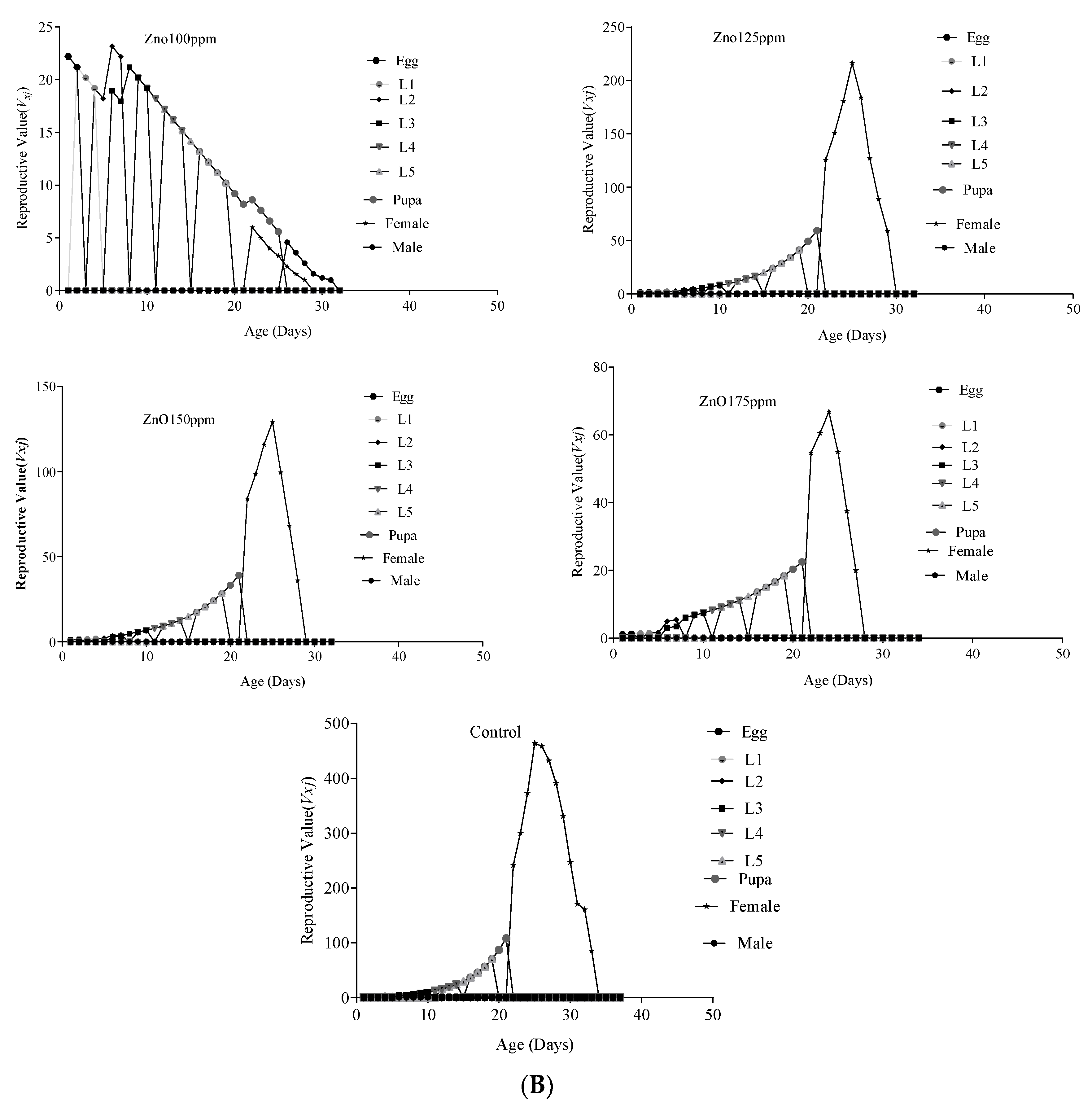


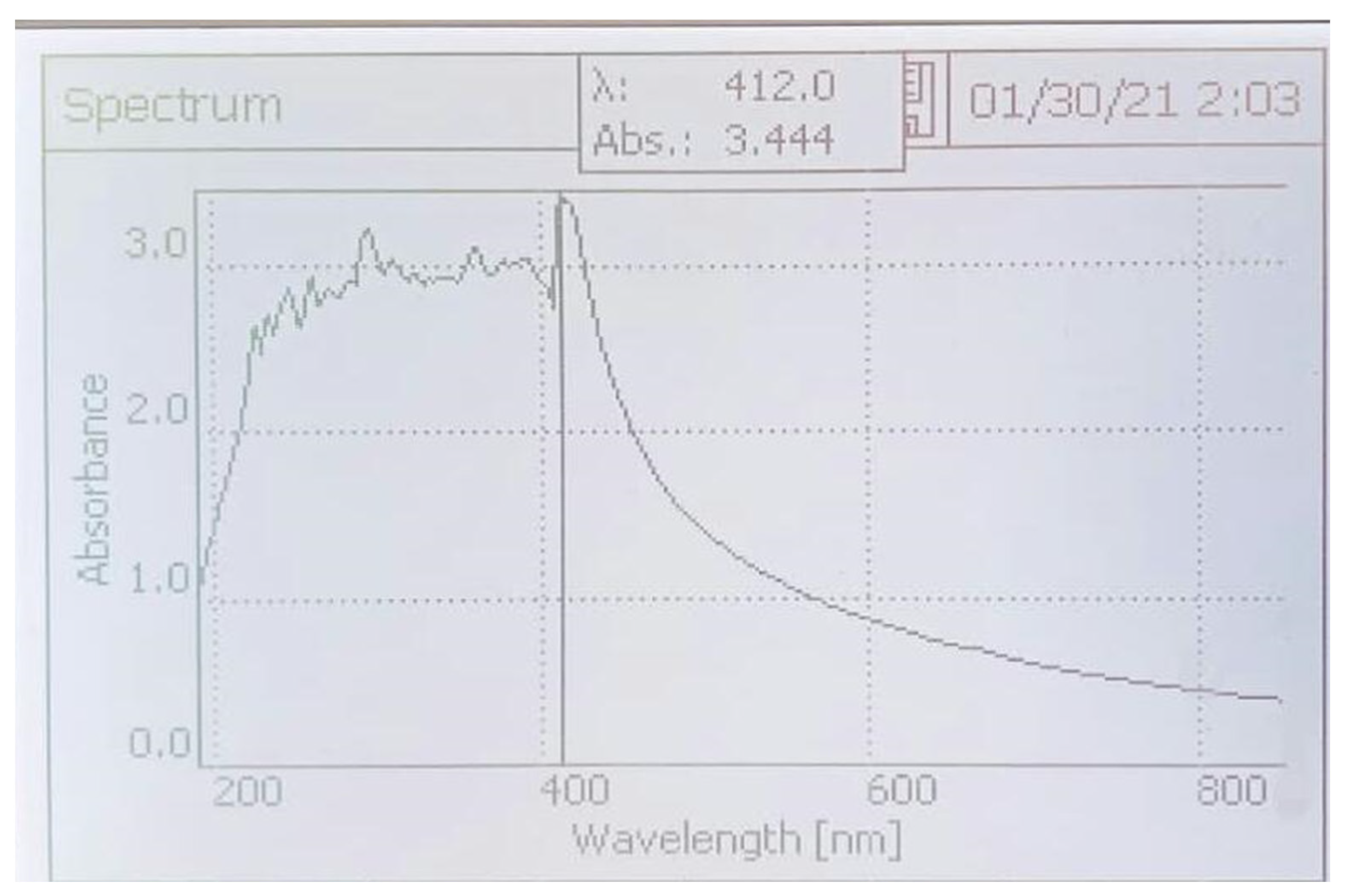


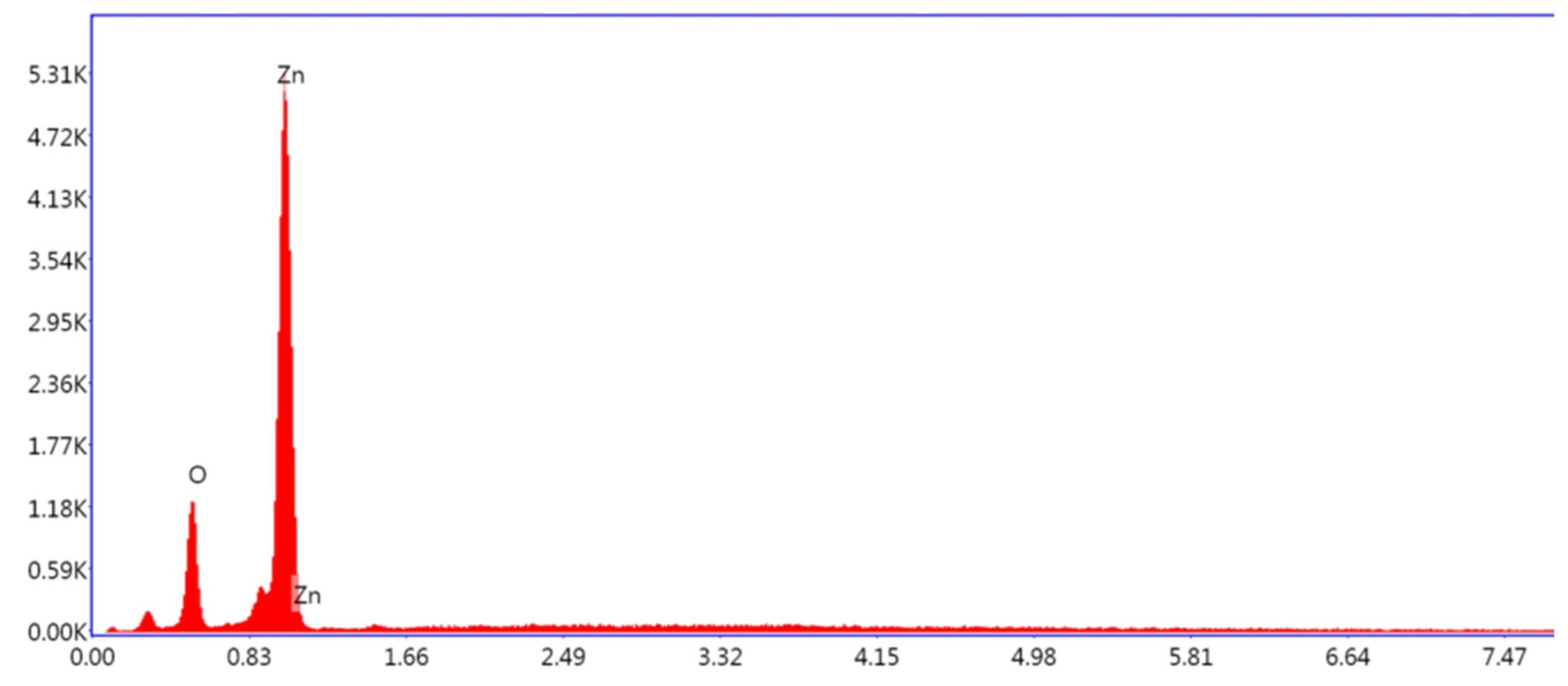
| Nanoparticles | Larval Instars | N | LC50 | Lower Limit | Upper Limit | LC90 | Lower Limit | Upper Limit | X2 | DF | Slope ± S. E | p |
|---|---|---|---|---|---|---|---|---|---|---|---|---|
| Ag NPs | 3rd instar | 30 | 114.674 | 95.257 | 127.342 | 202.719 | 176.213 | 273.744 | 3.20 | 3 | 4.90 ± 0.04 | 0.362 |
| 4th instar | 30 | 112.073 | 84.693 | 127.509 | 228.086 | 188.701 | 380.650 | 3.086 | 3 | 4.16 ± 0.04 | 0.379 | |
| 5th instar | 30 | 130.869 | 113.598 | 144.780 | 240.904 | 201.817 | 361.791 | 1.205 | 3 | 4.82 ± 0.04 | 0.752 | |
| ZnO NPs | 3rd instar | 30 | 127.792 | 108.708 | 142.106 | 242.977 | 201.746 | 379.737 | 0.247 | 3 | 4.49 ± 0.04 | 0.970 |
| 4th instar | 30 | 114.069 | 77.814 | 132.370 | 271.481 | 208.579 | 690.488 | 0.080 | 3 | 3.36 ± 0.06 | 0.994 | |
| 5th instar | 30 | 155.387 | 140.875 | 174.502 | 276.874 | 226.954 | 435.934 | 0.608 | 3 | 5.41 ± 0.04 | 0.895 |
| Nanoparticles | Parameters | Control | 100 ppm | 125 ppm | 150ppm | 175 ppm |
|---|---|---|---|---|---|---|
| Ag NPs | Eggs duration | 1.4 ± 0.09 a | 1.33 ± 0.09 a | 1.3 ± 0.09 a | 1.3 ± 0.09 a | 1.3 ± 0.09 a |
| 1st larval duration (d) | 1.9 ± 0.17 b | 2 ± 0 a | 2 ± 0 a | 2 ± 0 a | 2 ± 0 a | |
| 2nd larval duration (d) | 2.3 ± 0.09 a | 2.38 ± 0.1 a | 2.38 ± 0.1 a | 2.32 ± 0.1 a | 2.37 ± 0.11 a | |
| 3rd larval duration (d) | 3 ± 0 a | 3 ± 0 a | 3 ± 0 a | 3 ± 0 a | 3 ± 0 a | |
| 4th larval duration (d) | 3.44 ± 0.1 a | 3.53 ± 0.12 ab | 3.47± 0.12 ab | 3.46 ± 0.14 bc | 3.8 ± 0.2 c | |
| 5th larval duration (d) | 4.44 ± 0.1 a | 4.53 ± 0.51 ab | 4.47 ± 0.12 ab | 4.46 ± 0.14 bc | 4.8 ± 0.2 c | |
| Total larval duration (d) | 15.33 ± 0.29 a | 15.58 ±0.35 a | 15.42 ± 0.35 a | 15.38 ± 0.43 a | 16.4 ± 0.6 a | |
| Pupal duration (d) | 5.94 ± 0.24 a | 6.12 ± 0.12 a | 6.46 ± 0.32 a | 6.54 ± 0.21 a | 6.68 ± 0.14 a | |
| Pre-Adult duration (d) | 32.89 ± 0.39 a | 30.3 ± 0.33 a | 28.21 ± 0.46 a | 27.62 ± 0.49 a | 27.8 ± 0.66 a | |
| Female longevity (d) | 31.33 ± 0.27 a | 27 ± 0.71 b | 26.9 ± 0.5 b | 26.29 ± 0.42 b | 26 ± 1.48 b | |
| Male longevity (d) | 34.83 ± 0.27 a | 30.3 ± 0.33 b | 29.67 ± 0.44 b | 29.17 ± 0.31 b | 28.25 ± 0.63 b | |
| Fecundity | 785.27 ± 22.43 a | 291.56 ± 44.5 b | 269 ± 23.38 b | 170.43 ± 19.03 bc | 161 ± 0.43 c |
| Nanoparticles | Parameters | Control | 100 ppm | 125 ppm | 150 ppm | 175 ppm |
|---|---|---|---|---|---|---|
| ZnO NPs | Eggs duration | 1.01 ± 0.02 b | 1.4 ± 0.09 a | 1.33 ± 0.09 a | 1.33 ± 0.09 a | 1.2 ± 0.07 ab |
| 1st larval duration (d) | 2 ± 0 a | 2 ± 0 a | 2 ± 0 a | 2 ± 0 a | 2 ± 0 a | |
| 2nd larval duration (d) | 2.4 ± 0.09 a | 2.44 ± 0.1 a | 2.38 ± 0.1 a | 2.4 ± 0.1 a | 2.43 ± 0.14 a | |
| 3rd larval duration (d) | 3 ± 0 a | 3 ± 0 a | 3 ± 0 a | 3 ± 0 a | 3 ± 0 a | |
| 4th larval duration (d) | 3.44 ± 0.1 a | 3.5 ± 0.1 a | 3.43 ± 0.11 a | 3.45 ± 0.11 b | 3.55 ± 0.16 a | |
| 5th larval duration (d) | 4.4 ± 0.1 a | 4.5 ± 0.1 a | 4.43 ± 0.11 a | 4.45 ± 0.11 b | 4.55 ± 0.16 a | |
| Total larval duration (d) | 15.33 ± 0.29 a | 15.5 ± 0.31 a | 15.3 ± 0.32 a | 15.36 ± 0.33 a | 15.64 ± 0.47 a | |
| Pupal duration (d) | 5.24 ± 0.12 b | 6.24 ± 0.24 a | 6.34 ± 0.14 a | 6.46 ± 0.12 a | 6.64 ± 0.08 a | |
| Pre-Adult duration (d) | 32.89 ± 0.39 a | 29.79 ± 0.31 a | 28.61 ± 0.24 a | 28.18 ± 0.35 a | 27.91 ± 0.67 a | |
| Female longevity (d) | 31.33 ± 0.27 a | 29.17 ± 0.32 b | 27.85 ± 0.22 c | 27 ± 0.35 c | 26.2 ± 0.37 c | |
| Male longevity (d) | 34.83 ± 0.27 a | 30.42 ± 0.47 b | 29.6 ± 0.22 b | 29.6 ± 0.22 b | 29.33 ± 0.8 b | |
| Fecundity | 869.73 ± 18.41 a | 415 ± 19.21 b | 279.54 ± 9.74 c | 156.75 ± 15.24 d | 75.8 ± 3.72 e |
| Nanoparticles | Parameters | Control | 100 ppm | 125 ppm | 150 ppm | 175 ppm |
|---|---|---|---|---|---|---|
| Ag NPs | Intrinsic rate of increase (r) | 0.213730 | 0.1723 | 0.185601 | 0.14564 | 6.60483 |
| Net reproduction rate (R0) | 392.6333 | 87.4666 | 89.66666 | 39.7666 | 5.3666 | |
| Mean length of a generation (T) | 27.94586 | 25.945590 | 25.60402 | 25.2876 | 25.4390 | |
| Finite rate of increase (λ) | 1.23828 | 1.1880723 | 1.1919 | 1.15678 | 1.06827 | |
| Birth rate (at SASD *) | 0.24134 | 0.214441 | 0.2191 | 0.2031 | 0.15200 | |
| Survival rate (at SASD *) | 0.99694 | 0.973630 | 0.9727 | 0.95362 | 0.91627 | |
| Death rate (at SASD *) | 3.057097 | 2.63694 | 2.7215 | 4.6379 | 8.3728 | |
| ZnO NPs | Intrinsic rate of increase (r) | 0.21790 | 0.1892 | 0.181659 | 0.1598 | 0.1004 |
| Net reproduction rate (R0) | 434.8666 | 166 | 121.1333 | 62.7 | 12.6333 | |
| Mean length of a generation (T) | 27.8788 | 27.0079 | 26.40596 | 25.88731 | 25.2416 | |
| Finite rate of increase (λ) | 1.2434 | 1.2083 | 1.199205 | 1.1733 | 1.1057 | |
| Birth rate (at SASD *) | 0.24644 | 0.22366 | 0.21798 | 0.19609 | 0.1746 | |
| Survival rate (at SASD *) | 0.99702 | 0.98471 | 0.98122 | 0.9772 | 0.931025 | |
| Death rate (at SASD *) | 2.9758 | 1.52870 | 1.87748 | 2.2745 | 6.8974 |
Publisher’s Note: MDPI stays neutral with regard to jurisdictional claims in published maps and institutional affiliations. |
© 2022 by the authors. Licensee MDPI, Basel, Switzerland. This article is an open access article distributed under the terms and conditions of the Creative Commons Attribution (CC BY) license (https://creativecommons.org/licenses/by/4.0/).
Share and Cite
Asghar, M.S.; Sarwar, Z.M.; Almadiy, A.A.; Shami, A.; El Hadi Mohamed, R.A.; Ahmed, N.; Waghulade, M.S.; Alam, P.; Abd Al Galil, F.M. Toxicological Effects of Silver and Zinc Oxide Nanoparticles on the Biological and Life Table Parameters of Helicoverpa armigera (Noctuidae: Lepidoptera). Agriculture 2022, 12, 1744. https://doi.org/10.3390/agriculture12101744
Asghar MS, Sarwar ZM, Almadiy AA, Shami A, El Hadi Mohamed RA, Ahmed N, Waghulade MS, Alam P, Abd Al Galil FM. Toxicological Effects of Silver and Zinc Oxide Nanoparticles on the Biological and Life Table Parameters of Helicoverpa armigera (Noctuidae: Lepidoptera). Agriculture. 2022; 12(10):1744. https://doi.org/10.3390/agriculture12101744
Chicago/Turabian StyleAsghar, Muhammad Shahbaz, Zahid Mahmood Sarwar, Abdulrahman A. Almadiy, Ashwag Shami, Rania Ali El Hadi Mohamed, Nazeer Ahmed, Minakshi Sanjay Waghulade, Pravej Alam, and Fahd Mohammed Abd Al Galil. 2022. "Toxicological Effects of Silver and Zinc Oxide Nanoparticles on the Biological and Life Table Parameters of Helicoverpa armigera (Noctuidae: Lepidoptera)" Agriculture 12, no. 10: 1744. https://doi.org/10.3390/agriculture12101744






